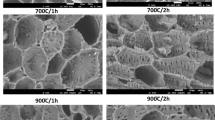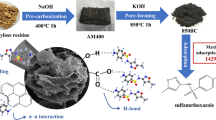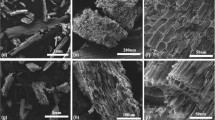Abstract
Biochar-inspired tertiary removal system is beneficial in preventing antibiotic residue discharged from hospital wastewater treatment. Taking advantage of a simple kiln controlled at around 600 °C, we succeeded in carbonizing corncobs to biochar with a surface area of 306 m2/g. Using ciprofloxacin (CFX), ofloxacin (OFX), and delafloxacin (DLX), we demonstrated the performance of the corncob biochar for the sorption removal. The pseudo-second-order rate of DLX was lower than CFX and OFX. The maximum sorption capacity Qmax of 93.9 μg/g for DLX, 399.6 μg/g for CFX, and 306.0 μg/g for OFX were estimated using the Langmuir model. The parameter KL relating to binding strength for DLX is 8 times larger than CFX and OFX. The Qmax could be mainly determined by the pore size distribution of the biochar and the dimensions of FQs considering hydration. Furthermore, we discussed that these results might relate to the number of halogen atoms and functional groups in the fluoroquinolones.






Similar content being viewed by others
References
Lien LTQ, Hoa NQ, Chuc NTK, Thoa N, Phuc H, Diwan V, Dat N, Tamhankar A, Lundborg C (2016) Antibiotics in wastewater of a rural and an urban hospital before and after wastewater treatment, and the relationship with antibiotic use-a one year study from Vietnam. Int J Environ Res Public Health 13:1–13. https://doi.org/10.3390/ijerph13060588
Martins AF, Vasconcelos TG, Henriques DM, Frank CS, König A, Kümmerer K (2008) Concentration of ciprofloxacin in Brazilian hospital effluent and preliminary risk assessment: a case study. Clean Soil, Air, Water 36:264–269. https://doi.org/10.1002/clen.200700171
Diwan V, Tamhankar AJ, Khandal RK, Sen S et al (2010) Antibiotics and antibiotic-resistant bacteria in waters associated with a hospital in Ujjain, India. BMC Public Health 10:414
Riaz L, Mahmood T, Khalid A, Rashid A, Ahmed Siddique MB, Kamal A, Coyne MS (2018) Fluoroquinolones (FQs) in the environment: a review on their abundance, sorption and toxicity in soil. Chemosphere 191:704–720. https://doi.org/10.1016/j.chemosphere.2017.10.092
Attallah OA, Al-Ghobashy MA, Nebsen M, Salem MY (2017) Adsorptive removal of fluoroquinolones from water by pectin-functionalized magnetic nanoparticles: process optimization using a spectrofluorimetric assay. ACS Sustain Chem Eng 5:133–145. https://doi.org/10.1021/acssuschemeng.6b01003
Conkle JL, Lattao C, White JR, Cook RL (2010) Competitive sorption and desorption behavior for three fluoroquinolone antibiotics in a wastewater treatment wetland soil. Chemosphere 80:1353–1359. https://doi.org/10.1016/j.chemosphere.2010.06.012
Meng F, Gao G, Yang TT, Chen X, Chao Y, Na G, Ge L, Huang LN (2015) Effects of fluoroquinolone antibiotics on reactor performance and microbial community structure of a membrane bioreactor. Chem Eng J 280:448–458. https://doi.org/10.1016/j.cej.2015.06.025
Nguyen TT, Bui XT, Dang BT, Ngo HH, Jahng D, Fujioka T, Chen SS, Dinh QT, Nguyen CN, Nguyen PTV (2019) Effect of ciprofloxacin dosages on the performance of sponge membrane bioreactor treating hospital wastewater. Bioresour Technol 273:573–580. https://doi.org/10.1016/j.biortech.2018.11.058
Kraemer SA, Ramachandran A, Perron GG (2019) Antibiotic pollution in the environment: from microbial ecology to public policy. Microorganisms 7:1–24. https://doi.org/10.3390/microorganisms7060180
Zhao J, Liang G, Zhang X, Cai X, Li R, Xie X, Wang Z (2019) Coating magnetic biochar with humic acid for high efficient removal of fluoroquinolone antibiotics in water. Sci Total Environ 688:1205–1215. https://doi.org/10.1016/j.scitotenv.2019.06.287
Cheng D, Ngo HH, Guo W, Chang SW, Nguyen DD, Li J, Ly QV, Nguyen TAH, Tran VS (2020) Applying a new pomelo peel derived biochar in microbial fell cell for enhancing sulfonamide antibiotics removal in swine wastewater. Bioresour Technol:123886. https://doi.org/10.1016/j.biortech.2020.123886
Wang H, Chu Y, Fang C, Huang F, Song Y, Xue X (2017) Sorption of tetracycline on biochar derived from rice straw under different temperatures. PLoS One 12:e0182776. https://doi.org/10.1371/journal.pone.0182776
Eduah JO, Nartey EK, Abekoe MK, Breuning-Madsen H, Andersen MN (2019) Phosphorus retention and availability in three contrasting soils amended with rice husk and corn cob biochar at varying pyrolysis temperatures. Geoderma 341:10–17. https://doi.org/10.1016/j.geoderma.2019.01.016
Yadav OP, Hossain F, Karjagi CG, Kumar B, Zaidi PH, Jat SL, Chawla JS, Kaul J, Hooda KS, Kumar P, Yadava P, Dhillon BS (2015) Genetic improvement of maize in India: retrospect and prospects. Agric Res 4:325–338. https://doi.org/10.1007/s40003-015-0180-8
Liu X, Zhang Y, Li Z, Feng R, Zhang Y (2014) Bioresource technology characterization of corncob-derived biochar and pyrolysis kinetics in comparison with corn stalk and sawdust. Bioresour Technol 170:76–82. https://doi.org/10.1016/j.biortech.2014.07.077
Hao F, Zhao X, Ouyang W, Lin C, Chen S, Shan Y, Lai X (2013) Molecular structure of corncob-derived biochars and the mechanism of atrazine sorption. Agron J 105:773–782. https://doi.org/10.2134/agronj2012.0311
Binh QA, Nguyen HH (2020) Investigation the isotherm and kinetics of adsorption mechanism of herbicide 2,4-dichlorophenoxyacetic acid (2,4-D) on corn cob biochar. Bioresour Technol Reports 11:100520. https://doi.org/10.1016/j.biteb.2020.100520
Peñafiel ME, Vanegas E, Bermejo D, Matesanz JM, Ormad MP (2019) Organic residues as adsorbent for the removal of ciprofloxacin from aqueous solution. Hyperfine Interact 240. https://doi.org/10.1007/s10751-019-1612-9
Shen Z, Zhang J, Hou D, Tsang DCW, Ok YS, Alessi DS (2019) Synthesis of MgO-coated corncob biochar and its application in lead stabilization in a soil washing residue. Environ Int 122:357–362. https://doi.org/10.1016/j.envint.2018.11.045
Zhang X, Zhang Y, Ngo HH, Guo W, Wen H, Zhang D, Li C, Qi L (2020) Characterization and sulfonamide antibiotics adsorption capacity of spent coffee grounds based biochar and hydrochar. Sci Total Environ:716. https://doi.org/10.1016/j.scitotenv.2020.137015
Kiecak A, Sassine L, Boy-Roura M, Elsner M, Mas-Pla J, le Gal la Salle C, Stumpp C (2019) Sorption properties and behaviour at laboratory scale of selected pharmaceuticals using batch experiments. J Contam Hydrol 225:103500. https://doi.org/10.1016/j.jconhyd.2019.103500
Peng B, Chen L, Que C, Yang K, Deng F, Deng X, Shi G, Xu G, Wu M (2016) Adsorption of antibiotics on graphene and biochar in aqueous solutions induced by π-π interactions. Sci Rep 6:1–10. https://doi.org/10.1038/srep31920
Tulkens PM, Van Bambeke F, Zinner SH (2019) Profile of a novel anionic fluoroquinolone - delafloxacin. Clin Infect Dis 68:S213–S222. https://doi.org/10.1093/cid/ciy1079
Candel FJ, Peñuelas M (2017) Delafloxacin: design, development and potential place in therapy. Drug Des Devel Ther 11:881–891. https://doi.org/10.2147/DDDT.S106071
ASTM D4607–94(1999) (1999) Standard test method for determination of iodine number of activated carbon. Astm Int 94:1–5
Ho YS, McKay G (1998) A comparison of chemisorption kinetic models applied to pollutant removal on various sorbents. Process Saf Environ Prot 76:332–340. https://doi.org/10.1205/095758298529696
Akaike H (1974) A new look at the statistical model identification. IEEE Trans Automat Contr 19:716–723. https://doi.org/10.1109/TAC.1974.1100705
Gupta GK, Ram M, Bala R, Kapur M, Mondal MK (2018) Pyrolysis of chemically treated corncob for biochar production and its application in Cr(VI) removal. Environ Prog Sustain Energy 37:1606–1617. https://doi.org/10.1002/ep.12838
Dalahmeh S, Ahrens L, Gros M, Wiberg K, Pell M (2018) Potential of biochar filters for onsite sewage treatment: adsorption and biological degradation of pharmaceuticals in laboratory filters with active, inactive and no biofilm. Sci Total Environ 612:192–201. https://doi.org/10.1016/j.scitotenv.2017.08.178
Mianowski A, Owczarek M, Marecka A (2007) Surface area of activated carbon determined by the iodine adsorption number. Energy Sources, Part A Recover Util Environ Eff 29:839–850. https://doi.org/10.1080/00908310500430901
Rodriguez A, Lemos D, Trujillo YT, Amaya JG, Ramos LD (2019) Effectiveness of biochar obtained from corncob for immobilization of lead in contaminated soil. J Heal Pollut 9:13–21. https://doi.org/10.5696/2156-9614-9.23.190907
Spiess A-N, Neumeyer N (2010) An evaluation of R2 as an inadequate measure for nonlinear models in pharmacological and biochemical research: a Monte Carlo approach. 1–11
Mutavdžić Pavlović D, Ćurković L, Grčić I, Šimić I, Župan J (2017) Isotherm, kinetic, and thermodynamic study of ciprofloxacin sorption on sediments. Environ Sci Pollut Res 24:10091–10106. https://doi.org/10.1007/s11356-017-8461-3
Do DD (1998) Adsorption analysis: equilibria and kinetics
Zhuang Y, Yu F, Ma J, Chen J (2015) Adsorption of ciprofloxacin onto graphene-soy protein biocomposites. New J Chem 39:3333–3336. https://doi.org/10.1039/c5nj00019j
Khokhar TS, Memon FN, Memon AA, Durmaz F, Memon S, Panhwar QK, Muneer S (2019) Removal of ciprofloxacin from aqueous solution using wheat bran as adsorbent. Sep Sci Technol 54:1278–1288. https://doi.org/10.1080/01496395.2018.1536150
Cavallo G, Metrangolo P, Milani R, Pilati T, Priimagi A, Resnati G, Terraneo G (2016) The halogen bond. Chem Rev 116:2478–2601. https://doi.org/10.1021/acs.chemrev.5b00484
Xiao F, Pignatello JJ (2015) π+-π Interactions between (hetero)aromatic amine cations and the graphitic surfaces of pyrogenic carbonaceous materials. Environ Sci Technol 49:906–914. https://doi.org/10.1021/es5043029
Chen Z, Xiao X, Chen B, Zhu L (2015) Quantification of chemical states, dissociation constants and contents of oxygen-containing groups on the surface of biochars produced at different temperatures. Environ Sci Technol 49:309–317. https://doi.org/10.1021/es5043468
Lawrinenko M, Laird DA (2015) Anion exchange capacity of biochar. Green Chem 17:4628–4636. https://doi.org/10.1039/c5gc00828j
Bassetti M, Righi E, Pecori D, Tillotson G (2018) Delafloxacin: an improved fluoroquinolone developed through advanced molecular engineering. Future Microbiol 13:1081–1094. https://doi.org/10.2217/fmb-2018-0067
Carabineiro SAC, Thavorn-Amornsri T, Pereira MFR et al (2012) Comparison between activated carbon, carbon xerogel and carbon nanotubes for the adsorption of the antibiotic ciprofloxacin. Catal Today 186:29–34. https://doi.org/10.1016/j.cattod.2011.08.020
Goyne KW, Chorover J, Kubicki JD, Zimmerman AR, Brantley SL (2005) Sorption of the antibiotic ofloxacin to mesoporous and nonporous alumina and silica. J Colloid Interface Sci 283:160–170. https://doi.org/10.1016/j.jcis.2004.08.150
Zhao X, Ouyang W, Hao F, Lin C, Wang F, Han S, Geng X (2013) Properties comparison of biochars from corn straw with different pretreatment and sorption behaviour of atrazine. Bioresour Technol 147:338–344. https://doi.org/10.1016/j.biortech.2013.08.042
Laine J, Simoni S, Calles R (1991) Preparation of activated carbon from coconut shell in a small scale cocurrent flow rotary kiln. Chem Eng Commun 99:15–23. https://doi.org/10.1080/00986449108911575
L.D.Landau, E.M.Lifshitz (1987) Fluid mechanics: volume 6 (course of theoretical physics). Pergamon Press
Acknowledgments
We are grateful to Mr. Ueyama of Kyowakiden Co., Ltd. for taking the SEM image of the biochar. We especially thank the technical staff of the Renewable Energy Research Center of Maejo University. They kindly helped use the kiln to pyrolyze the corncob biochar.
Funding
This work was partially supported by JSPS KAKENHI Grant Number 20K20640.
Author information
Authors and Affiliations
Corresponding author
Ethics declarations
Competing interests
The authors declare that they have no competing interests.
Additional information
Publisher’s Note
Springer Nature remains neutral with regard to jurisdictional claims in published maps and institutional affiliations.
Supplementary Information
ESM 1
(DOCX 21.4 kb)
Rights and permissions
About this article
Cite this article
Dang, BT., Gotore, O., Ramaraj, R. et al. Sustainability and application of corncob-derived biochar for removal of fluoroquinolones. Biomass Conv. Bioref. 12, 913–923 (2022). https://doi.org/10.1007/s13399-020-01222-x
Received:
Revised:
Accepted:
Published:
Issue Date:
DOI: https://doi.org/10.1007/s13399-020-01222-x




